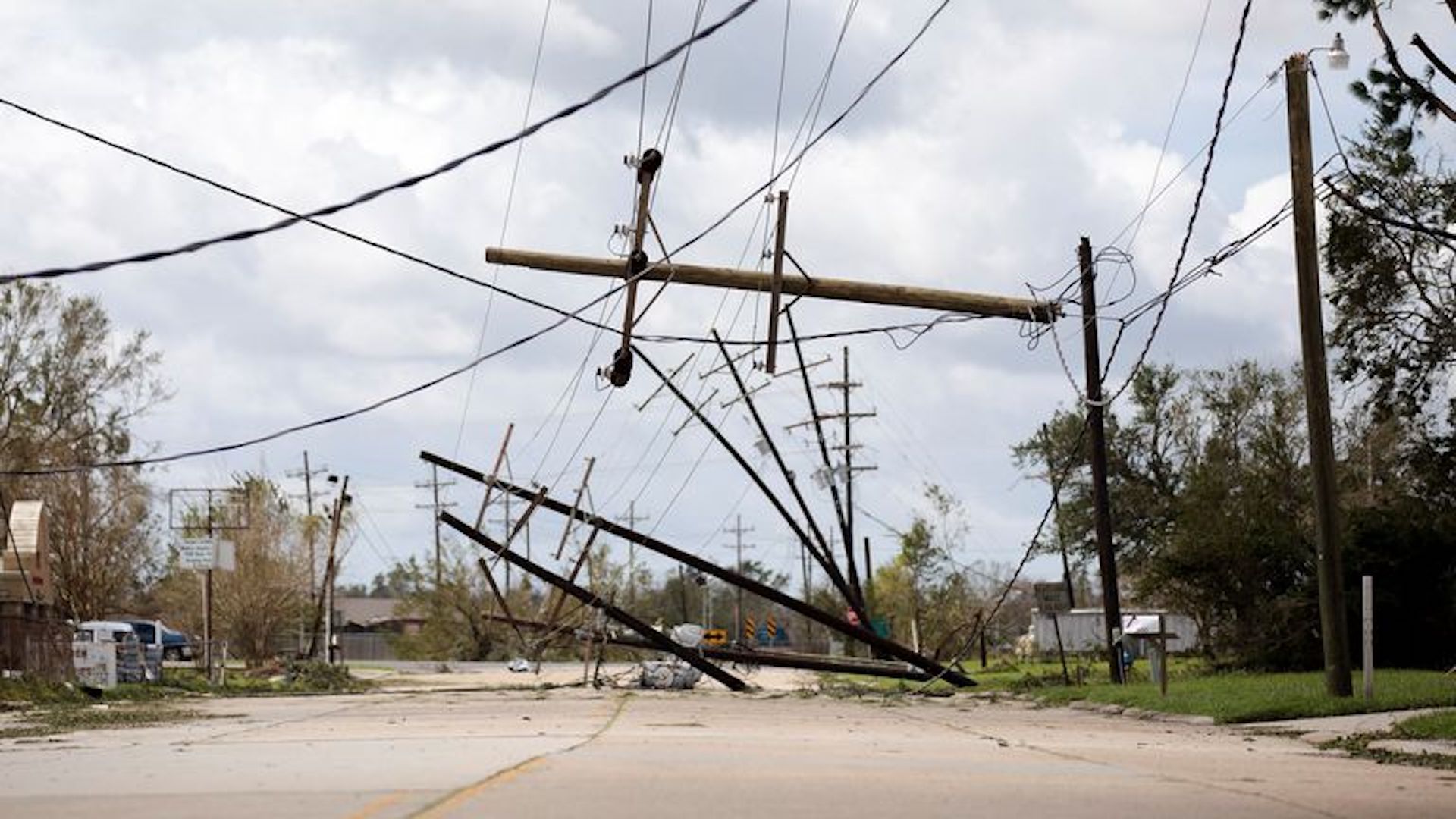| | | | | | | Presented By Cognite | | | | Axios Generate | | By Ben Geman and Andrew Freedman ·Sep 01, 2021 | | 🐪 It's Wednesday! Today's Smart Brevity count is 1,301 words, 5 minutes. 📊 Data point of the day: $281 billion, the estimated value of global carbon markets last year, a 23% increase. (WSJ) 🛢️Situational awareness: "OPEC and its allies will meet today to review its plans for reviving halted oil production, with delegates expecting the group will ratify another increase in October." (Bloomberg) 🎵 And yesterday marked the 1993 release of the Cannonballs' album "Last Splash," which provides today's intro tune... | | | | | | 1 big thing: Air pollution cuts 2.2 years of life expectancy |  The average person is losing about 2.2 years of life expectancy due to air pollution, according to new research by the University of Chicago's Energy Policy Institute, Andrew writes. Driving the news: The Air Quality Life Index published Wednesday shows that the burden of harmful air pollution is unevenly distributed — with China making measurable progress in cleaning up its air, and other global hotspots now concentrated in South Asia and Sub-Saharan Africa. - There is new evidence showing that climate change caused by fossil fuel burning is affecting air quality in developed nations through emerging feedbacks like wildfire smoke, for example.
- The index attempts to clearly indicate how emissions of tiny particles, called fine particulates, are having an effect on people's health worldwide.
- The most hazardous particulate matter is known as PM2.5, due to its tiny size of 2.5 micrometers, much smaller than the width of a human hair. These particles, generated from power plants, cars and other sources, are harmful to human health.
Between the lines: According to EPIC director Michael Greenstone, when considered across the global population, air pollution is robbing people of 17 billion years of life expectancy. - "It may be impossible to think of some other feature of our lives that we have caused that is robbing all of us of so much wellness and life. And that's just the reduction of life expectancy, people while they're alive they're leading sicker lives," Greenstone told Axios.
What they found: According to the AQLI, which is based on peer-reviewed studies, China still has air pollution challenges, but it is seeing a significant enough reduction in emissions of fine particulate matter to show up in the data. - If China were to meet air quality standards set by the World Health Organization, the study shows that people would live an average of 2.6 years longer.
- Particulate pollution in China has declined by 29% since 2013, the report finds — adding about 1.5 years onto average life expectancy, "assuming these reductions are sustained," the report finds.
By the numbers: Indian residents would gain an additional 5.9 years, on average, in life expectancy if they were to breathe air in accordance with WHO standards. - Bangladesh would have a life expectancy gain of 5.4 years and Nepal five years.
- In Ghana, the gain in life expectancy from reducing air pollution would be the same as in China, 2.6 years, the report finds.
- In the Niger Delta region of Nigeria, the report states, air quality is similar to South Asia.
The intrigue: One new trend identified in the report is the interaction between climate change and air pollution, with one worsening the other. Read more |     | | | | | | 2. Where it stands: Ida's energy aftermath |  | | | Power lines downed by Hurricane Ida are seen in Houma, Louisiana, on Aug. 30. Photo: Nick Wagner/Xinhua via Getty Images | | | | The restoration of Gulf Coast power services and petroleum facilities won't be quick, easy or clean, Ben writes. Driving the news: Almost 988,000 homes and businesses are without power in Louisiana, per tracking service PowerOutage.U.S. — a slight improvement from the storm's immediate aftermath. - On the petro front, Argus Media notes that "the stage is set for many slow, grinding weeks of refinery repairs and restarts," with at least three sustaining damage.
What we're watching: "Damage assessments are underway at some refineries, but operations cannot restart until power and other essential third-party utilities are restored," the Energy Department said in its latest storm update. - Per S&P Global Platts, about 75% of Louisiana's refining capacity was offline as of yesterday.
- The Interior Department reports that almost all Gulf of Mexico crude oil and gas production remained shut-in.
Yes, but: "The refinery and offshore platform shut-ins are not anticipated to cause any immediate supply issues," DOE said. - Platts notes that offshore crude oil and gas output could return to "more normal levels" by the weekend or early next week, though damage to Port Fourchon, a major hub, is another wrinkle.
Meanwhile, at the retail fuels level, GasBuddy's Patrick De Haan reports that significant numbers of gasoline stations lack fuel in Baton Rouge and New Orleans. Threat level: The Financial Times reports of Shell's damaged Norco refinery: "Black smoke billowed from the refinery's gas flares, which the company said in a Facebook post could be expected until power was restored." Meanwhile, the National Weather Service has issued a heat advisory for Wednesday in New Orleans, Baton Rouge and Houma, Louisiana, to Gulfport, Mississippi, as residents swelter without power to run air conditioning. |     | | | | | | Bonus: The Gulf's crude oil footprint |  Data: EIA; Chart: Axios Visuals The Gulf of Mexico's share of overall U.S. oil production has declined significantly since 2005's deadly Hurricane Katrina thrashed the region, Ben writes. Why it matters: That's among the reasons Hurricane Ida, while pushing fuel prices up somewhat, isn't causing anything near the kind of surge that occurred 16 years ago. - The chart above shows how U.S. production soared over the last decade thanks to the onshore shale boom, so the Gulf's share of the total pie is smaller.
Yes, but: U.S. refining capacity is still heavily concentrated in the region, so storms can still wreak havoc on the wider fuel system. |     | | | | | | A message from Cognite | | The countdown to 2050 has begun | | |  | | | | What are the global leaders of technology and industry doing to drive the energy transition, digitalize legacy industries, and reach net-zero by 2050? Find out at Ignite Talks, one of the world's largest industrial technology and digitalization conferences, September 21-23. Register here. | | | | | | 3. NASA to measure the noise of Joby's electric air taxi |  | | | A Joby electric air taxi. (Joby Aviation). | | | | NASA and Joby Aviation are kicking off acoustic measuring tests as part of a program to promote public confidence in emerging aviation markets, Joby announced Wednesday, Andrew writes. Why it matters: If electric air taxis are to gain wide adoption, they need to be quiet aircraft, so measuring their precise noise footprint gives Joby an early mover advantage versus the competition in this area. The big picture: The testing, Joby claims, will make the company the first to fly an all-electric vertical takeoff and landing (eVTOL) aircraft as part of NASA's Advanced Air Mobility Campaign. - Joby went public on the New York Stock Exchange last month and aims to start commercial use of its tilt-rotor aircraft in 2024.
How it works: The two-week test campaign will take place at Joby's base near Big Sur, California, where NASA has deployed an array of more than 50 pressure ground plate microphones to measure Joby aircraft's sound emissions from multiple directions. What they're saying: "From day one, we prioritized building an aircraft that not only has an extremely low noise profile, but blends seamlessly into the natural environment," said Joby founder and CEO JoeBen Bevirt, in a press release. - Specifically, Joby's blades and other components were designed to avoid the loud "whop, whop, whop" sounds made by traditional helicopters.
What's next: Joby is aiming to gain FAA certification of its four-seat, zero-emissions electric air taxis in 2023. |     | | | | | | 4. Treasury hopes to tackle climate insurance risks |  | | | Illustration: Aïda Amer/Axios | | | | The Treasury Department just launched a new effort to grapple with how climate change is affecting the insurance market and, by extension, financial markets more broadly, Ben writes. Driving the news: Treasury, via the Federal Insurance Office, is soliciting information on topics like data needed to measure and assess the sector's climate-related risk exposures and "climate-related issues or gaps in the supervision and regulation of insurers." - More broadly, the office is looking to assess the potential for "major disruptions" of private insurance in markets especially vulnerable to climate change.
- The Wall Street Journal points out that the effort will affect FIO's work with states, which are the primary insurance regulators.
What they're saying: "The increased frequency and severity of climate-related disasters, as well as the magnitude of associated insured losses, highlight the significance of these climate-related financial risks and the role of insurers in responding to them," the notice states. Threat level: Treasury notes that some consumers are finding it increasingly tough to find affordable property insurance in some markets. - The department is also emphasizing insurers' wider role in financial markets, noting that life insurers are among the largest investors in U.S. capital markets.
- "As owners of significant amounts of assets, insurers could be vulnerable to potential decreases in asset values arising from the transition towards a low-carbon economy," Treasury said.
|     | | | | | | 5. Quote of the day | | "Off-roading in the R1T is a mind-bender." That's a line from MotorTrend's new review of Rivian's electric pickup truck that's just hitting the market. |     | | | | | | A message from Cognite | | The countdown to 2050 has begun | | |  | | | | What are the global leaders of technology and industry doing to drive the energy transition, digitalize legacy industries, and reach net-zero by 2050? Find out at Ignite Talks, one of the world's largest industrial technology and digitalization conferences, September 21-23. Register here. | | | | 🙏 Thanks for reading! Please tell your friends to sign up for this newsletter here, and we'll see you tomorrow. |  | | It'll help you deliver employee communications more effectively. | | | | | | Axios thanks our partners for supporting our newsletters. If you're interested in advertising, learn more here.
Sponsorship has no influence on editorial content. Axios, 3100 Clarendon Blvd, Suite 1300, Arlington VA 22201 | | | You received this email because you signed up for newsletters from Axios.
Change your preferences or unsubscribe here. | | | Was this email forwarded to you?
Sign up now to get Axios in your inbox. | | | | Follow Axios on social media:    | | | | | |









No comments:
Post a Comment